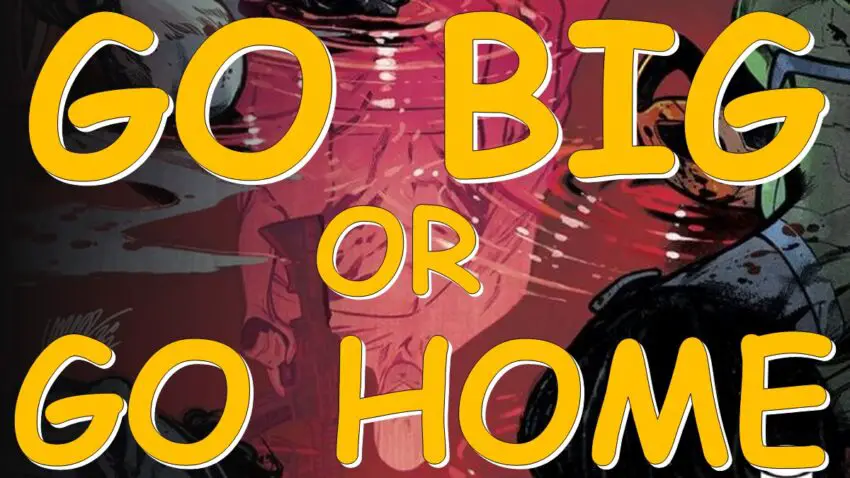This week, Image Comics released the second issue of Mark Millar’s Summer crossover event – BIG GAME #2. If it’s not immediately obvious from the title of this Op-Ed, BIG GAME #2 is our pick of the week because it does everything right for a Summer event comic, starting with one big idea.
Without spoiling anything beyond the basic solicit information, Dr. Crane and the Chrononauts go back in time to verify a theory. When they return, all Hell breaks loose.

The remarkable thing about comics is the infinite amount of scale and scope you can create with absolutely no difference in budget. You can have two characters in a powerfully dramatic scene during a backyard picnic, or you can have a crew of thousands in a spaceship visit the ends of the known universe. The only practical limit is the creator’s imagination.
But to make it work, you need to have one big idea, and you need to execute it with at least one big swing to make the idea pay off. Considering the avalanche of reviews we handle on the regular, we see writers get one or neither right with unsurprisingly mediocre results. But when a creator gets both in a comic, the results are almost always positive.
What’s the one BIG Idea?
The big idea is one central development or message that creates a new purpose for the story, forces the story to change course, or gives the story a whole new meaning than what you thought.
In HUNT. KILL. REPEAT. #3 from Mad Cave Studios, the Greek God Artemis is on a revenge mission against Zeus and the rest of the gods for killing her husband and child. During the issue, Artemis learns that not only is her son alive but that Zeus is secretly raining the boy without Artemis’s knowledge or consent. The revelation flips the entire arc from a simple revenge plot into a rescue scenario, and it’s executed beautifully.
The one BIG idea is Artemis’s revelation that her son is alive and how that knowledge changes everything. The big idea doesn’t have to be big in size, but it has to be big in impact and importance to the story. Big enough to overshadow every side conversation, character moment, or subplot to take over the reader’s memory.
When a comic doesn’t have one big idea, the comic is, more often than not, unfocused or covers a lot of ground with stuff that you won’t remember five minutes after finishing it. If you’re laying out the plot of a multi-issue arc as a writer, next to every issue should be a note that clearly, concisely states the one big idea of the issue.
Swing Big, Or Go Home
Cliffhangers are fine. There’s nothing wrong with a last page or last panel cliffhanger, but too often we see creators use the last page surprise as a crutch to cover for the rest of the 20+ pages of forgettable, irrelevant pap that came before it.
When a writer stringently focuses on the one big idea, everything else going on around that idea – before, during, and after – should either be intentionally changed by that idea to remold the story into something new or exist to support the idea’s execution. A character may take a solo trip to answer a call for help. A family member may visit unexpectedly, just in time for a confluence of events to reach a boiling point. An unusual storm may pop up to make visibility difficult.
To the earlier point about budgets, employ anything and everything to support the execution of your one big idea to make it hit as hard as possible when you swing. Change the weather. Curve the universe. Bring down the fist of God. Do whatever you have to do to bring that idea to life with the biggest, loudest bang possible.
The reader should feel a physical reaction to the idea when it lands. Kill the puppy. Kill your darlings. Crack the Earth in two. It’s okay. You can make it whole or remake it into something new, but the point is to avoid timid, milquetoast stories that feel grounded and mundane.
BIG GAME #2 Gets It Right
Why is BIG GAME #2 our book of the week and related to this topic? Simple. Mark Millar clears the board, meaning “nobody is safe.” In a superhero crossover comic, that’s a pretty big idea.
Do Millar and ace artist Pepe Larraz swing big? Boy, howdy, do they?!? Figuratively and literally. The issue reads like an avalanche chasing you down a mountain, leaving you exhausted and slightly shocked. When you examine the issue, you see how every action the characters take is methodically placed to lead up to that one big idea’s execution to make it as impactful as possible.
If you’re a comic writer, figure out your big idea first. Then, position your characters and subplots to be impacted by the idea when it hits, or place characters and moments to strategically support the idea to make it bigger. You’ll be glad you did.
We hope you found this article interesting. Come back for more reviews, previews, and opinions on comics, and don’t forget to follow us on social media:
If you’re interested in this creator’s works, remember to let your Local Comic Shop know to find more of their work for you. They would appreciate the call, and so would we.
Click here to find your Local Comic Shop: www.ComicShopLocator.com
As an Amazon Associate, we earn revenue from qualifying purchases to help fund this site. Links to Blu-Rays, DVDs, Books, Movies, and more contained in this article are affiliate links. Please consider purchasing if you find something interesting, and thank you for your support.

